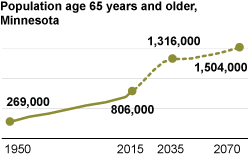
There are currently about 806,000 adults age 65 and older in Minnesota, making up about 15 percent of the population. Two decades from now, that population is projected to top 1.3 million, and more than one out of every five Minnesotans will be an older adult. Twenty years from now is also when Minnesota is expected to hit the peak “retirement- to working-age ratio,” with nearly two retirement-age adults for every five working-age Minnesotans, compared to the current 1-to-5. This huge demographic shift will have widespread impact on Minnesota’s economy, health care system, and social services.
Greater Minnesota is “greyer” than the Twin Cities
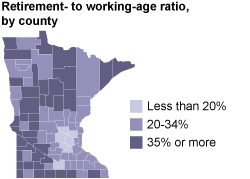
Most greater Minnesota counties have a higher proportion of older residents than the Twin Cities. Many of these counties already have a ratio of one senior for every three working-age adults, compared to 1-to-5 or 1-to-6 ratios in the Twin Cities and suburbs. Communities in greater Minnesota face unique challenges in meeting the needs of aging populations and changing economies, including maintenance and development of transportation and other infrastructure, access to broadband, shifts in traditional industries, and stagnating or declining working-age populations.
Older adults are less racially and ethnically diverse than the state population overall
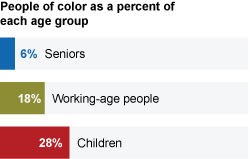
Only about 6 percent of Minnesota seniors are people of color, compared to 18 percent of working-age people and 28 percent of children. Older Minnesotans are also less likely to be foreign born than working-age adults (5% of seniors, vs. 10% of people ages 20-64).
Community engagement among older adults is high
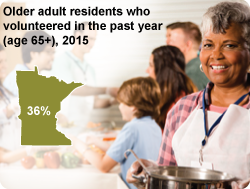
Thirty-six percent of Minnesota adults age 65+ report volunteering in the past year, the fourth highest percentage in the nation. Minnesota’s older adults are also the most likely of any age group to vote. And 74 percent of Minnesotans age 65+ report helping or being helped by a neighbor in the past year.
Most older adults own their homes
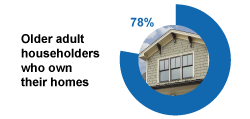
Seventy-eight percent of Minnesota’s older adult householders own their homes. However, about a third of older adult-headed households are paying an unaffordable amount for housing.
Many older adults work beyond traditional retirement age
 Traditional retirement age is 65 years, but we know that many older adults continue working for years or decades after their 65th birthday. Today, about a quarter of 65-74-year-olds are still in the workforce, along with 6 percent of adults 75 and older. Projections show that Minnesota will have 3.1 million jobs in 2024, but only about 2.7 million working-age adults employed. Older-adults could help fill about half of the shortfall if current employment levels continue.
Traditional retirement age is 65 years, but we know that many older adults continue working for years or decades after their 65th birthday. Today, about a quarter of 65-74-year-olds are still in the workforce, along with 6 percent of adults 75 and older. Projections show that Minnesota will have 3.1 million jobs in 2024, but only about 2.7 million working-age adults employed. Older-adults could help fill about half of the shortfall if current employment levels continue.
